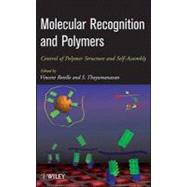
Note: Supplemental materials are not guaranteed with Rental or Used book purchases.
Purchase Benefits
What is included with this book?
Vincent Rotello is the Goessmann Professor in the Department of Chemistry at the University of Massachusetts, Amherst. His research emphasizes achieving a fundamental understanding of supramolecular chemistry and applying it to issues in biology and nanoscience including delivery, sensing, and devices.
S. Thayumanavan is a Professor in the Department of Chemistry at the University of Massachusetts, Amherst. His research focuses on the design and synthesis of novel macromolecules (dendrimers and polymers) that have applications in chemistry, biology, and materials science. Examples of these applications include catalysis and transport, drug and gene delivery, and light harvesting and sensory materials.
| List of Tables, Figures, Charts and Schemes | |
| Dedication | |
| Preface | |
| Acknowledgements | |
| Editor Bibliographies | |
| List of Contributors | |
| Fundamentals Of Supramolecular Polymers | |
| A Brief Introduction to Supramolecular Chemistry in a Polymer Context | |
| Introduction and Background | |
| Main-chain versus Side-chain Supramolecular Polymers | |
| References | |
| Molecular Recognition Using Amphiphilic Macromolecules | |
| Introduction | |
| Amphiphilic Block Copolymers | |
| Non-Specific Interactions | |
| Specific Interactions | |
| Amphiphilic Homopolymers | |
| Container Properties | |
| Amphiphilic Dendrimers | |
| Conclusions | |
| Acknowledgements | |
| References | |
| Supramolecular Control of Mechanical Properties in Single Molecules, Interfaces and Macroscopic Materials | |
| Introduction and Background | |
| Mechanical Properties of Linear Supramolecular Polymers | |
| Mechanical Properties of Supramolecular Polymer Networks | |
| Mechanical Properties in Supramolecular Polymers at Interfaces | |
| Mechanical Forces and Supramolecular Interactions | |
| Conclusions | |
| References | |
| Polymer Formation And Self-Assembly | |
| Hydrogen Bond Functionalized Block Copolymers and Telechelic Oligomers | |
| Scientific Rationale and Perspective | |
| Hydrogen Bonding Interactions in Macromolecular Design | |
| Fundamentals of Hydrogen Bonding | |
| Performance Advantages of Hydrogen Bond Containing Polymers | |
| Hydrogen Bond Containing Block Copolymers | |
| Telechelic Hydrogen Bond Functional Polymers | |
| Combining Hydrogen Bonding with other Non-Covalent Interactions | |
| Reversible Attachment of Guest Molecules via Hydrogen Bonding | |
| Conclusions and Summary | |
| References | |
| Non-Covalent Side-chain Modification | |
| Introduction | |
| Strategies Towards Noncovalent Side-Chain Functionalization of Polymeric Scaffolds | |
| Noncovalent Multifunctionalization of the Side-Chains of Polymeric Scaffolds | |
| Applications of Noncovalently Functionalized Side-Chain Copolymers | |
| Conclusions and Outlook | |
| Acknowledgements | |
| References | |
| Polymer-Mediated Assembly of Nanoparticles Using Engineered Interactions | |
| Introduction | |
| Design of Nanoparticles and Polymers | |
| Self-Assembly Polymer-particle Nanocomposites | |
| Conclusions and Outlook | |
| References | |
| Metallo-Supramolecular Polymers, Networks, and Gels | |
| Introduction | |
| Metal-Ligand Binding Motifs | |
| Linear and Macrocyclic Main-Chain Metallo-Supramolecular Polymers | |
| Metallo-Supramolecular Networks and Gels | |
| Conclusion and Outlook.References | |
| Polymeric Capsules: Catalysis and Drug Delivery | |
| Introduction | |
| Methods of Encapsulation | |
| Catalyst Encapsulation | |
| Drug Delivery with Microcapsules | |
| Conclusion | |
| References | |
| Sequence-Specific Hydrogen-Bonded Units for Directed Association, Assembly and Ligation | |
| Introduction | |
| General Design: Information-Storing Molecular Duplexes Based on the Recombination of H-Bond Donors and Acceptors | |
| Quadruply H-Bonded Duplexes with Sequence-Independent Stability | |
| Tuning Binding Strength | |
| Table of Contents provided by Publisher. All Rights Reserved. |
The New copy of this book will include any supplemental materials advertised. Please check the title of the book to determine if it should include any access cards, study guides, lab manuals, CDs, etc.
The Used, Rental and eBook copies of this book are not guaranteed to include any supplemental materials. Typically, only the book itself is included. This is true even if the title states it includes any access cards, study guides, lab manuals, CDs, etc.